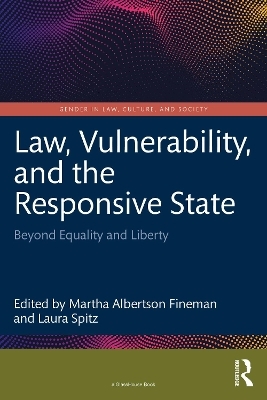
Law, Vulnerability, and the Responsive State
Routledge (Verlag)
978-1-032-34663-2 (ISBN)
Vulnerability theory argues a “vulnerable legal subject” should displace the “liberal legal subject” that currently dominates law and policy. The theory is based on the fundamental empirical realities of the material body and offers an alternative to a social contract or rights-based notion of state responsibility, both of which tend to privilege abstractions such as rationality or dignity. A vulnerability analysis poses law and policy questions based on the “vulnerable legal subject” and requires new thinking about state or governmental responsibility. To achieve a truly comprehensive and inclusive notion of what constitutes social justice or a universal or common good, vulnerability theory mandates a reassessment of both equality and freedom as these concepts are currently conceived. Presenting the work of scholars from a wide range of doctrinal areas, it is this task that the book takes up. In particular, in recognizing that many social or institutional relationships entail uneven positions of dependence and reliance, it maintains that individualized notions of equality or freedom are inadequate and must be reformulated to include a sense of collective or social justice, incorporating asymmetric or unequal allocations of responsibility, and requiring appropriate limitations on the individual.
This book’s reorientation of the subject, as well as the central objectives of law and policy, will appeal to scholars and students in law, vulnerability studies, gender studies, critical legal and political theory, politics, philosophy, and sociology.
Martha Albertson Fineman is Robert W. Woodruff Professor of Law and the Founding Director of The Vulnerability and Human Condition Initiative at Emory University, Georgia, USA. Laura Spitz is Vice Provost for Global Engagement and Professor of Law at Seattle University, Washington, USA.
List of Contributors
Introduction: Understanding Vulnerability
Martha Albertson Fineman
I. The Fallacy and Foibles of Vulnerability as Particular
II. Vulnerability Theory
A. Reasoning From the Body
B. Embedded—The Necessity of Social (and Legal) Arrangements
III. Theoretical Implications of “Reasoning From the Body”
IV. Conclusion
PART I
Legal Structures: The Constitution and the Mechanisms of Justice
1 Restructuring the Constitution for Human Resilience
Martha T. McCluskey
Introduction
I. Structural Principles for Constitutional Power
II. Contemporary Right-Wing Constitutional Restructuring
III. Vulnerability Theory’s Constitutional Reframing
IV. Affirming the Administrative State for Human Resilience
V. Conclusion
2 Vulnerability Theory and Access to Justice: Elaborating Possibilities for Legal System Design
Andrew Pilliar
1. Background on Access to Justice
a. What Is “Access to Justice”?
b. How Common Are Access to Justice Problems?
2. Situating Vulnerability
a. Vulnerability Theory and Responsive Law
b. Vulnerability Theory and the Capability Approach
3. Realizing Person-Centred Access to Justice
4. Conclusion
PART II
Role of Social Movements in Vulnerability Theory
3 Toward a Responsive Landscape: The Role of Social Movements in Vulnerability Theory
Kathryn Abrams
Introduction
I. Learning From Social Movements: Cultivating Resilience in Arizona
II. Social Movements and Vulnerability Theory: Three Questions
A. Do Social Movements Help to Meet Human Vulnerability?
III. How Does the Work of Social Movements Relate to the Activity of the Responsive State?
A. Density and Effects of Regulatory Frameworks
IV. Directions for Vulnerability Theory
4 Law, Public Policy, and Social Movements to Support
and Strengthen Individual and Collective Interests of Labor
Risa L. Lieberwitz
Introduction
I. The Role of the State to Provide for the Public Welfare
A. The Vision of the Responsive State
B. The Reality of the Unresponsive State in the U.S.
II. The Role of the State in the Employment Relationship
A. The “Private Welfare” System in the U.S.
B. The Liberal Contradictions of the National Labor Relations Act
C. Legislative Reforms to Move Toward a Responsive State
D. Recent Legal and Social Developments that Resonate With the Reforms of the PRO Act
III. Conclusion
PART III
Organizing the Economic Infrastructure
5 The Corporation, Vulnerability, and Resilience
Lua Kamál Yuille
Introduction
I. Vulnerability, the Human Condition, and the Liberal Legal Subject
II. Understanding Resilience
III. The Corporation as a Site of Resilience
A. Conceiving of the Corporation
B. Corporate Resilience
IV. Toward a Responsive State Approach to the Corporation
6 Market Citizenship, Resilience Drainage, and the Role of Private Law
Hila Keren and Ronit Donyets-Kedar
Introduction
I. The Private-Public Divide and the Role of Private Law
II. Resisting Resilience Drainage via Contract Law
A. The Problem: Market Rejections and Humiliation
B. A Vulnerability-Based Response
III. Resisting Resilience Drainage via Corporate Law
A. The Problem of Market Evangelism
B. A Vulnerability-Based Response
IV. Conclusion
PART IV
The Public Nature of “Private” Property
7 Housing Trusts and Resilient Cities: Hierarchy, Resources, and Resilience
Marc L. Roark
Vulnerability and Affordable Housing Resilience
Affordable Housing as an Inherent Vulnerability
How Cities Sought Resilience in the Form of Housing Trust Funds
Scale, Resilience Gaps, and Responsibility
8 Vulnerability, Resilience, and the Fair Housing Act
Xiaoqian Hu
I. Some Limits of the FHA
A. Excessive Deference to Defense
B. Illegal Immorality Versus Legal Privilege
C. A Vulnerability Evaluation
II. Reinterpreting the FHA Through Vulnerability Theory
A. A Social-Situational View of Harm and Discrimination
B. A Reconceptualized State for Systemic Action
III. Conclusion
PART V
The Ultimate “Private” Space—The Construction of the Family
9 The Elder Catch: Engineering the Future of Caregiving
Jessica Dixon Weaver
I. Vulnerability Theory and Resistant Assets
A. The Taxonomy of Vulnerability Theory
B. Resistant Assets and the Non-Responsive State
II. The Family as a Resistant Asset
III. State and Market Response to the Elder Catch
10 Vulnerability Theory and the Conception of Time
June Carbone and Naomi Cahn
Part I: The Pandemic
Part II: Secure Versus Precarious Family Regimes
Part III: Vulnerability Theory
PART VI
Dimensions of Public and Private in Health Care
11 A Vulnerability Approach to the “Right to Health Care”: Addressing Epistemic Vulnerability
Matthew B. Lawrence
Introduction
A. The “Right to Health Care” and the Challenges of an Entitlement Approach
1. The Popular “Right to Health Care”
2. Operationalizing the “Right to Health Care”: The Role of Theory
3. Entitlement Approach and Its Limitations
B. Vulnerability Approach: From Entitlement to Obligation
1. Vulnerability Replaces Individual Entitlement With Collective (or State) Obligation
2. What Is the Content of the State’s Obligation?
3. A Collective, Procedural Right to Priority
C. Addressing Epistemic Vulnerability
1. Epistemic Vulnerability
2. Respond or Reject?
3. Separating Stepping Stones From Stumbling Blocks
12 Disability, Vulnerability, and Public Health Emergencies
Ani B. Satz
Introduction
I. Limits of Current Approaches
II. Reasoning From the Body
III. Disability, the Vulnerable Subject, and Health Law
IV. Disability and the Vulnerable Institution: Hospitals and Public Health Authorities
V. Disability and Resilience in Public Health Emergencies
VI. Conclusion
PART VII
Vulnerability and Sovereignty
13 Using Vulnerability Theory to Reconceive the Relationships Between Native Nations, the United States, and State Governments
Nazune Menka and Laura Spitz
Introduction
I. (Dependent) Sovereignty
a. Background: Sovereignty and Liberalism
b. Domestic Dependent Nations
II. Using Vulnerability Theory to Reconceptualize Sovereignty and the Doctrines of Plenary Power and Trust Responsibility
a. Assertion of Tribal Sovereignty Remains a Critical Component of Inherent Indigenous Power
b. Sovereignty Is Inter-Dependent
c. Indigenous Peoples Are Not a Vulnerable Population
d. Trust Responsibility Can and Should Be Detached From the Doctrine of Plenary Power
III. A Contemporary Example: The Indian Child Welfare Act
IV. Conclusion: Vulnerability Theory, Tribal Sovereignty and Federal Responsibility
Index
| Erscheinungsdatum | 10.10.2023 |
|---|---|
| Reihe/Serie | Gender in Law, Culture, and Society |
| Zusatzinfo | 1 Tables, black and white; 1 Line drawings, black and white; 1 Illustrations, black and white |
| Verlagsort | London |
| Sprache | englisch |
| Maße | 156 x 234 mm |
| Gewicht | 430 g |
| Themenwelt | Geisteswissenschaften ► Philosophie |
| Recht / Steuern ► Allgemeines / Lexika | |
| Recht / Steuern ► Arbeits- / Sozialrecht ► Sozialrecht | |
| Recht / Steuern ► EU / Internationales Recht | |
| ISBN-10 | 1-032-34663-9 / 1032346639 |
| ISBN-13 | 978-1-032-34663-2 / 9781032346632 |
| Zustand | Neuware |
| Haben Sie eine Frage zum Produkt? |
aus dem Bereich


